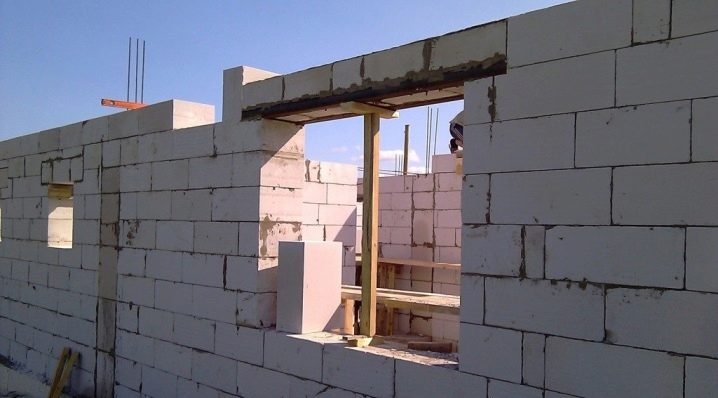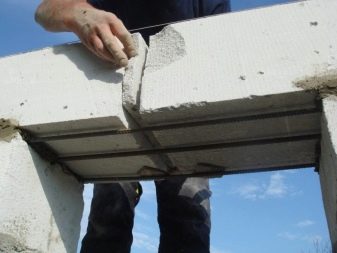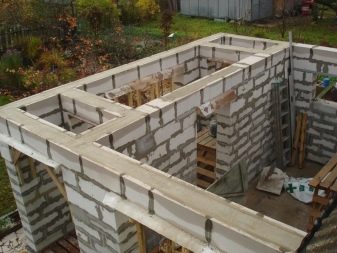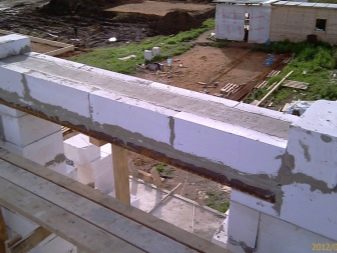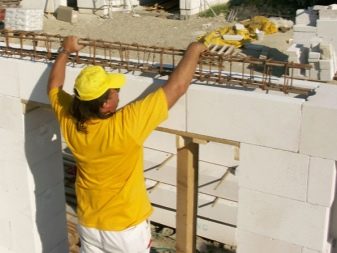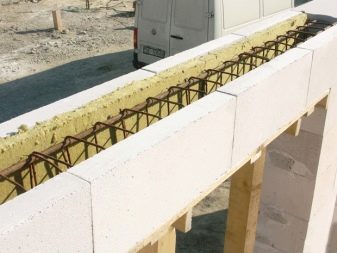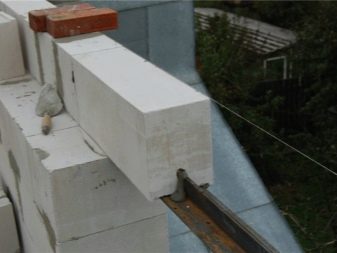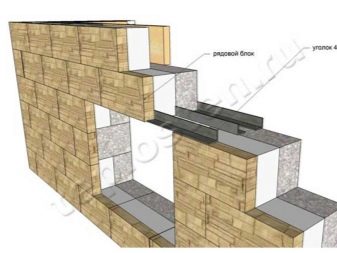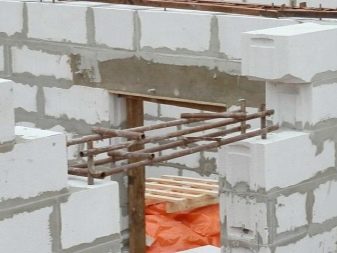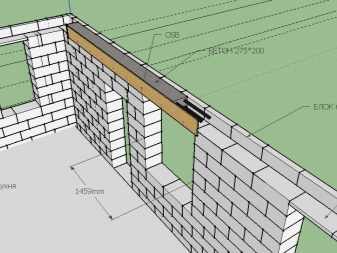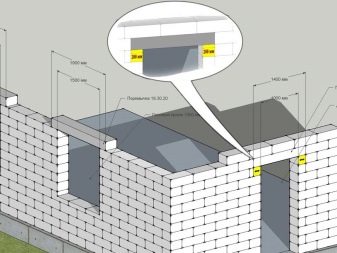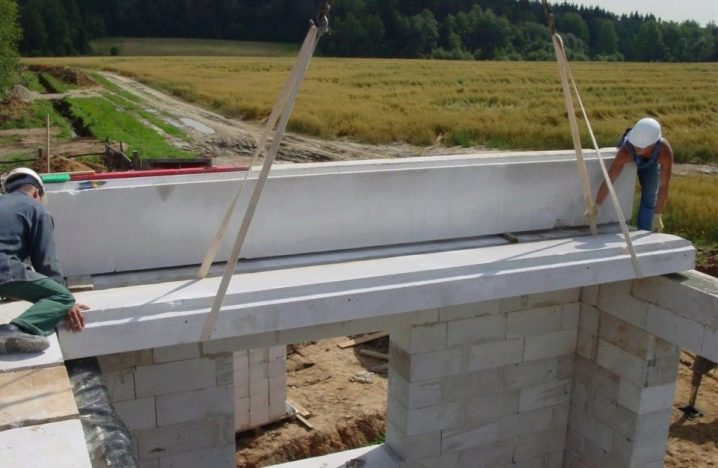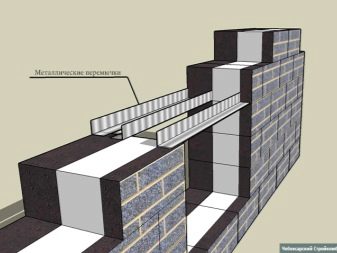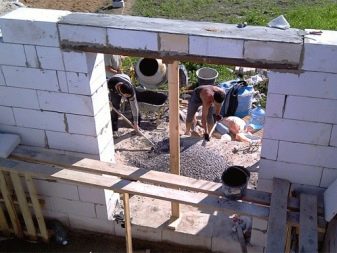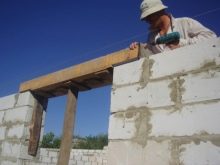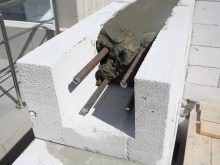Which jumpers are better suited for aerated concrete blocks?
The question of what kind of lintels (above-window or above-construction) and when used when building a house is not so simple. Most self-builders usually use home-made lintels of bar, monoliths and reinforced concrete structures using a steel angle when blocking the wall opening. But today, large companies that produce aerated concrete products, offer solutions that facilitate and accelerate the construction of door and window openings, and in some cases allow you to avoid the presence of such structures.
Species
First of all, let's look at how to choose lintels for window and door openings.This is decided depending on the availability of materials and the size of the spans that overlap. The most significant distance can be covered by monolithic reinforced concrete beams. Permanent formwork for them is usually made of U-shaped blocks of aerated concrete.
The above types of masonry are constantly subjected to significant pressure both during the construction of the walls and during the further operation of the building. As a rule, to evenly distribute the loads, the reinforcement bar is installed using wall chasers in such a way as to ensure that the rods enter the grooves. The latter are filled with a solution, and the rod is placed into it in such a way that a part of the rod 30 cm long remains outside.
The use of steel corners is not regulated by the State Standards or the rules for the construction of buildings made of aerated concrete, but it is popular among amateur builders.
In order to preserve the properties that prevent heat leakage through the outer walls of a concrete building, it is possible to bridge the window or door opening using one of the concrete concrete products: either reinforced concrete blocks D700, or monolithic reinforced concrete bridges in fixed concrete formwork.
If the cellular structure of the structure of gas blocks will coincide with the structure of the material of the building gas block, this similarity will not cause a decrease in the effective heat capacity. As a result, you will not need to additionally insulate the wall and masonry.
Another acceptable solution that will help cover the distance of 3 m can be the arrangement monolithic structure of reinforced concrete, flooded using non-separable formwork from U-shaped blocks. Their strength can be inferior only to structures such as monolithic reinforced concrete beams.
Lifting equipment for the installation of U-block jumpers is not required, but efforts are needed for a larger amount of preparation, as well as to make such a jumper, more time and effort will be required.
When reinforcing a structure in a U-shape block using a spatial reinforcement cage (U-blocks 20 cm wide with a tray having a width of 12 cm), two reinforcing bars (upper and lower) are allowed. All blocks with dimensions of width of trays from 15 cm are reinforced with four reinforcing bars (2 upper and 2 lower). At the same time, it is necessary to have transverse reinforcement ligaments with a distance of 40–50 cm between them.
If the wall opening in the aerated concrete wall is not wider than 1.2 m, and the condition of the ratio of height to width of the opening is 1 to 2/3, then the opening can be arranged without a lintel at all. With this design, each row is laid using a temporary stable formwork, using only glue for aerated concrete blocks.
You can also use structural reinforcement to reinforce aerated concrete blocks above the opening. Here d6d8 reinforcement can be used either thicker, setting its ends beyond the projection of faces by 50 cm, anchoring the ends at L-shaped angles.
If this proportion is not observed (1 to 2/3) due to the lack of height, it is necessary to use an ordinary non-bearing bridge with the shelf down (if the opening is less than 2 m) or a steel corner (if the opening is less than 1.2 m).
Perhaps the use of the corner, whose shelf width is smaller than those described in reference books (11 cm), or the opening angle is wider than 1.2 m. It should be noted that such an application will be substandard, and if you make it your own hands, it will remain at the discretion of the builder.
Features that must be borne in mind if it is planned to build a supporting structure (lintel) of the opening from the steel corner:
- steel corner must be painted on top of rust on both sides;
- in this case, the minimum length of the bearing angle on the aerated concrete should be 20 cm;
- with each other, the corners are fastened with steel tape / welded method / wire ties;
- they must be flush in the aerated concrete block;
- if there are future wall plastering plans, use a plaster net to wrap it.
Constructions of reinforced concrete monoliths allow to cover the widest distances. The proportion of calculation is as follows: 1 to 20. Calculation with a higher degree of accuracy for nadokonny and naddverny bridges and gas-block walls should be made in accordance with Ch. 9 STONAAG3.1-2013.
The reinforced concrete lintels are reinforced in the same way as a reinforced concrete beam: 4–6 d-12 reinforcing bars and thicker with transverse reinforcement bars half a meter.
The minimum length of support for RC beams on aerated concrete must be at least 35 cm. The support zone of RC structures of this type must be strengthened by arranging the discharge support using a mesh of reinforcement in the mortar layer or layers of adhesive for aerated concrete with a thickness of at least 1 5 cm
The above-reinforced concrete lintels are cast in a stable folding formwork, the removal time which is determined by measuring the level of air temperature at the place of work. Structures of this type can be deepened to the thickness of the layer of insulation material, which will necessarily be used to insulate the so-called cold bridges. ExtPolis is usually glued to structures of a similar type of different cross section with different adhesives for gas blocks and secured with dish-shaped dowels.
In addition, in some cases it is recommended to install non-separable elements using EkstPolis type thermal insulation sheets.
Structural features provide an opportunity to choose the options for the use of technology during installation, the length of the part of the support of jumpers on the gas-concrete wall, as well as the basic rules for their use.
Depth of bearing
This parameter, as a rule, depends on the type of jumpers.
- Supporting structure of aerated concrete with reinforcement: the maximum opening is 1 m 75 cm, the depth of the support is 25 cm. No additional warming is required.
- Bearing reinforced concrete structures with non-separable formwork of U-block structures: the maximum opening is 3 m, the depth of the bearing on the masonry is 25 cm. No additional warming is required.
- Monolithic supporting structures made of reinforced concrete. Must match the length of the beams - 35 cm. Requires additional insulation. Reinforcement is performed - 1 m 20 cm. The armature stands for the dimensions of the opening by 50 cm. It is recommended that ordinary reinforcement be used above the openings.
- Monolithic non-bearing reinforced concrete structures 200 cm 35 cm: maximum opening - 1 m 20 cm, depth of bearing on the masonry - 20 cm. Additional insulation is required. It is a non-bearing structure using a metal corner as the base. Must be deepened at base of masonry.
What to choose?
Since monoliths made of reinforced concrete weigh much more, and such a device is lighter than gazoblok to arrange window and door lintels, it is better to choose aerocrete: they are easier, they are easier to install, and also they are more advantageous in their insulating qualities.
Subtleties of installation
Aerated concrete lintels of reinforced look are durable due to the presence of a steel frame.Also, due to the fact that similar bridges are used during the erection of walls of aerated concrete, an optimal surface is obtained, which later serves the purpose of decoration.
Such bridges are a single-span beam receiving a load on its entire surface. The best option when laying aerated concrete - these are four corners of steel, laid properly.
It is recommended that the corners be laid on the masonry at a distance of about 30 cm. Using jumpers of this type is a rather complicated matter.
The process of mounting a metal lintel is as follows:
- select the required height;
- reinforcing rods are mounted;
- formwork installation is in progress;
- formwork is being strengthened;
- reinforcement bars are reinforced;
- Concrete casting of reinforcement rods is performed.
When laying over the openings is created, its width and height must be taken into account. This information will be very useful when the design is calculated. If their installation is correct, it will greatly affect the strength of the whole structure.
How to make jumpers in the walls of aerated concrete, see the video below.
